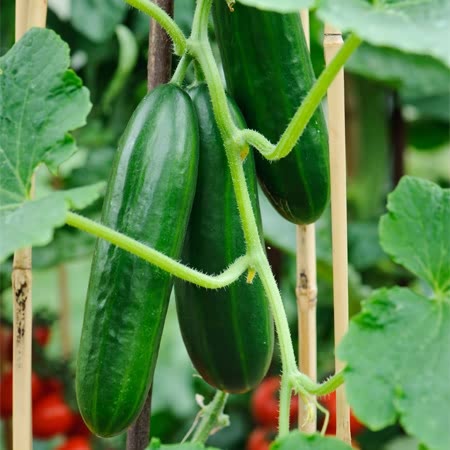Cucumber – Passandra F1
€3.95
Description
Cucumber – Passandra F1 produces high quality medium sized (15cm) cucumbers. It is also tolerant of mildew. My favourite.
Sowing:
Late April until mid June.
Sow individual seeds into small pots (7cm) or large modules and keep in a warm place. Pot on into a 10cm pot when ready. Plant into greenhouse or polytunnel. Two plants should be sufficient.
Spacing:
Between rows: 1m
Between plants in the row: 50cm
Approx. seed count: 5
Growing Cucumber – Passandra F1
Latin name:
Cucumis sativus
Family:
Cucurbitaceae
In my opinion, cucumbers are the most prolific and rewarding greenhouse or tunnel crop of all. From one single plant, provided it is well grown – you can expect to harvest well over 50 delicious cucumbers. Cucumber – Passandra F1 is the healthiest and most prolific type.
There is one very important thing to remember though – cucumbers are tropical plants so spoil them with warmth and moisture.
Cucumbers can grow very quickly but they can also die quickly if conditions are wrong.
Soil and site:
Cucumbers love warmth, high humidity and very high soil fertility. Just imagine a plant that grows to well over 2m tall and produces dozens of large fruits. It really needs to be well fed. I usually incorporate plenty of very well rotted compost or manure into the beds about a month before planting. Always plant them in full light with no shading from neighbouring plants.
Sowing:
It is absolutely crucial that you should only sow “all female” F1 hybrids. Open pollinated varieties have both male and female flowers and quite unlike most other plants, the cucumber can produce fruit from unpollinated flowers. The trouble with pollinated fruit is that they are bitter, tough skinned, full of hard seeds and with a “belly” at the end. So keep the males away from the cucumbers! If you do grow a variety that also produces male flowers you have to remove the male flowers before they open every day.
As cucumbers are heat loving and quick growing plants I delay sowing until mid April and make a second sowing in late May. I sow seeds individually into small pots (7cm) and place the pots into a propagator (21ºC) or on a warm windowsill. The seeds germinate quickly within five days. About two to three weeks after sowing the plants are ready to be potted on into a bigger (12cm) pot using a more fertile potting compost. The plants should remain in a warm place until planting.
Planting:
When the plants are well rooted in the 12cm pots before they get pot-bound they can be planted into their final growing position in the greenhouse or polytunnel. I train the plants up strings that are attached to an overhead wire so when I plant them I first dig a big enough planting hole and then lay the bottom part of the string into the hole with the end sticking up, then take the cucumber plant out of the pot and place it over the string and gently firm them in leaving no air pockets around the roots. It is advisable not to plant cucumbers too deep or even to let the top of the compost stick out a bit. This reduces the risk of stem rot.
Spacing:
Plants should be spaced 60cm apart in the row and only a single row should be planted per bed.
Plant care:
Just remember, cucumbers need a tropical environment so regular misting with warm water especially during the day is highly beneficial. On a weekly basis you should gently wind the main stem of the plant around the upright string and remove all side shoots. The side shoots grow from the joint between the leaves and the stem and so do the fruits. Ensure that you don’t remove the little cucumbers.
All the fruit from the bottom 30cm should be removed while still small otherwise the cucumbers will lie on the ground and get eaten by slugs or infected by diseases. This early fruit removal enables the plants to grow stronger.
As soon as you notice that the leaves of the cucumbers lose their vigour you can sprinkle some organic poultry pellets around the base of the plants, but make sure they are not touching the stems. I usually do this in July.
Layering:
When the plants reach the top of the string and have yielded a substantial amount of fruits they can be layered. This will substantially prolong their productive season. Unfortunately many gardeners are not aware of this and tend to give up on their crop. You simply prune all the leaves except from the top 75cm of the plants. Then you untie the string from the overhead wire and lay the plants flat on the ground towards one side of the bed. Tie an extension to the string so it will reach the wire again. Just leave 75cm of the plant to stick up and spread a layer of a good compost/soil mixture (about 15cm deep) over the laid cucumber stems. The plants will root at each node and start growing up again and hopefully yielding a few dozen more cucumbers.
Harvesting:
There are few things that are more impressive than the yield of cucumbers. Every day each plant produces a new cucumber during the high season. Use a sharp knife or secateurs to cut them off. Cucumbers are ready when the ends of the fruits are roundish. It is absolutely important that you harvest the crop regularly. Over mature fruit will substantially lower the overall yield and encourage plant diseases.
How much to grow?
In theory one plant is more than sufficient, but I always grow at least two in case I have a casualty.
Potential problems:
Frost damage:
Any touch of cold and your cucumber plants will suffer. The slightest frost will kill them and don’t forget that an unheated greenhouse or polytunnel provides very little frost protection.
Red spider mite:
These are serious pests especially in a greenhouse or polytunnel. They are difficult to spot with the naked eye. They form fine webs so they cross from one leaf to another. Mites feed by sucking sap from the leaves and this causes yellow spotting on the upper side of the leaves and eventually leads to complete yellowing of the leaves which become covered in fine cobwebs. As mites thrive in dry, hot conditions spray your cucumber plants regularly with warm water. If the problem recurs every year you should introduce a biological control that feeds on red spider mites.
Stem rot:
Stem rot is a fairly common problem with cucumbers. Infected plants rot away at the base. As a prevention always rotate cucumbers and never plant them in cold wet soil. As mentioned above it really helps to plant them slightly raised above soil level.
Varieties:
Cucumber – Passandra F1
For more information have a look at my monthly newsletters on:
https://greenvegetableseeds.com/newsletters/
For information on organic certification:
Have a look at the Irish Garden magazine:




